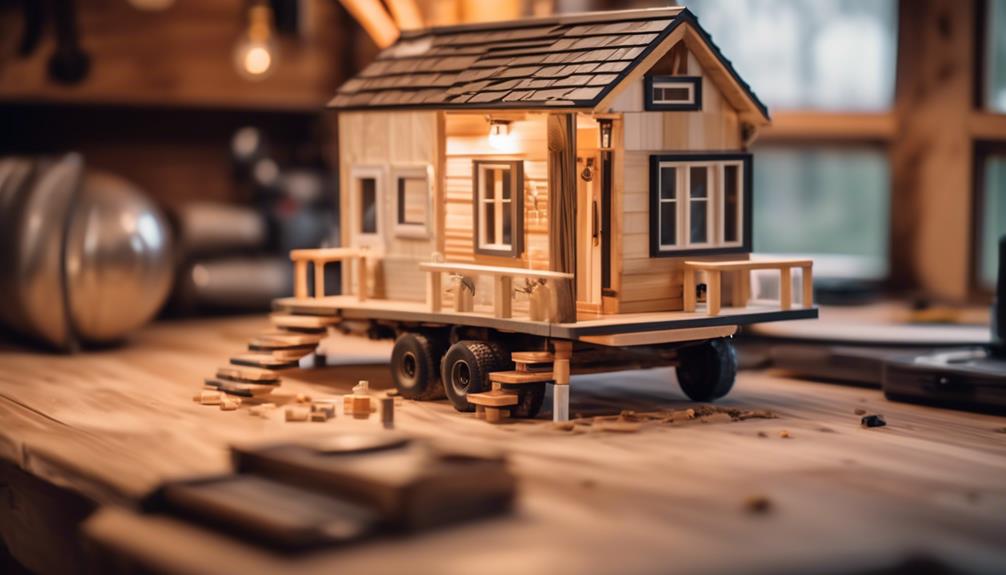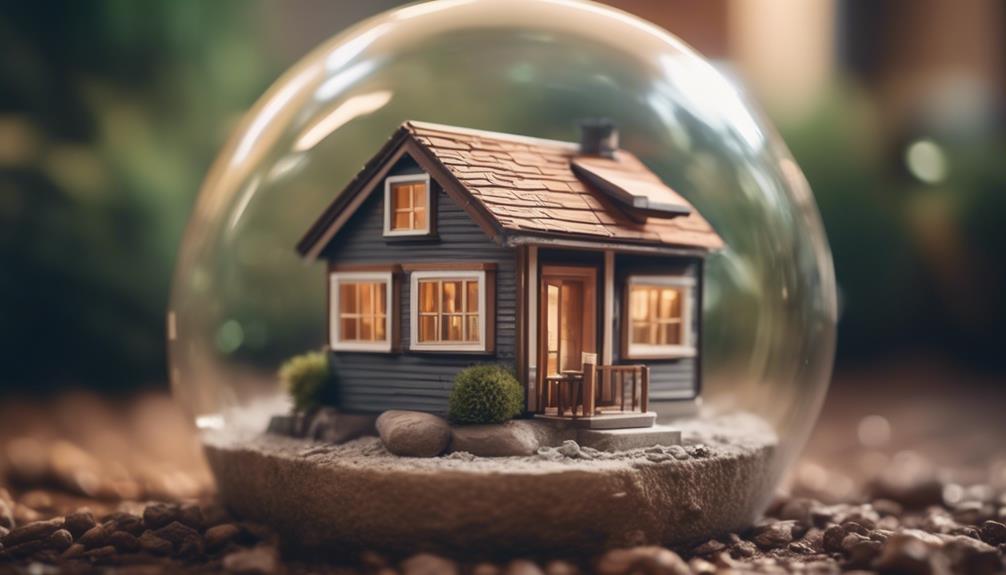Welcome to the fascinating world of tiny house living, where attention to detail and precision are paramount.
In this article, we will delve into the art of leveling your tiny home, a critical skill that ensures stability and functionality.
As you embark on this journey towards mastering the art of leveling, we will explore the importance of a level foundation, the tools and equipment needed, and provide step-by-step instructions on achieving a perfectly level tiny house.
But that's not all, we will also discuss common challenges you may encounter and share expert tips for maintaining a level tiny home.
So, if you're ready to discover the secrets of leveling like a pro, read on and unlock the key to a safe and secure tiny house living experience.
Key Takeaways
- Leveling is essential for stability, safety, and proper functionality of a tiny house.
- Visual inspection alone is not reliable for achieving proper leveling.
- The use of tools such as bubble levels, laser levels, jack stands, and tape measures is necessary for accurate leveling.
- Regular inspections and adjustments are crucial for maintaining a level tiny house and ensuring its structural integrity.
The Importance of Leveling
Leveling is a crucial aspect of tiny house living, ensuring stability, safety, and proper functionality of the structure. Properly leveling a tiny house can prevent structural damage, ensure doors and windows operate smoothly, and prevent appliances from malfunctioning.
One of the most common mistakes made when leveling a tiny house is relying solely on visual inspection, which can lead to an uneven foundation. Instead, it is recommended to use leveling techniques such as using a spirit level, measuring the height of each corner, and adjusting the support blocks accordingly.
Another important aspect of leveling is understanding the weight distribution of the house and ensuring that it is evenly distributed.
Tools and Equipment Needed
To properly level a tiny house and ensure stability and safety, specific tools and equipment are necessary.
One essential tool is a bubble level, which helps determine if the house is level horizontally and vertically. In addition to a bubble level, a laser level can be used for more accurate measurements.
Jack stands are also important for supporting the tiny house during the leveling process. These stands provide stability and prevent the house from shifting while adjustments are being made.
Another important tool is a tape measure, which is used to measure the height and distance between the ground and the structure.
Finally, it is crucial to have a set of blocks or shims to make adjustments and fine-tune the leveling process.
Following proper tools and techniques, along with leveling safety precautions, is essential for a stable and secure tiny house.
Step-by-Step Leveling Process

Before beginning the leveling process for a tiny house, gather all the necessary tools and equipment to ensure a precise and accurate adjustment. Once you have all the required items, follow this step-by-step process to level your tiny house effectively:
- Start by parking your tiny house on a flat surface. Use a level to determine which side of the house is higher or lower.
- Place leveling blocks or jacks under the low side of the house. Gradually raise the low side until it is level with the high side.
- Check the level of the house using a bubble level. Make adjustments as needed to achieve a perfectly level position.
- Double-check the levelness of the house by measuring the distance from the ground to the bottom of the house at multiple points. Ensure that all measurements are consistent.
- Once the house is level, secure it in place by using stabilizing jacks or blocks.
To avoid leveling mistakes and ensure safety during the process, always use appropriate safety precautions such as wearing protective gear and working with a partner.
Common Challenges and How to Overcome Them
One common challenge that may arise during the leveling process of a tiny house is ensuring stability on uneven terrain. This can be especially difficult when dealing with limited space and weight restrictions.
However, there are several techniques that can be employed to overcome this challenge. One option is to use adjustable leveling jacks, which can be positioned under the corners of the house and adjusted to compensate for uneven ground.
Another technique is to use concrete blocks or gravel pads to create a stable foundation. These can be placed strategically under the house to provide support and level the structure.
Additionally, using a laser level or water level can help ensure accuracy during the leveling process.
Maintaining a Level Tiny House

When it comes to maintaining a level tiny house, it is crucial to implement regular inspections and adjustments to ensure the stability and structural integrity of the dwelling. To achieve this, the following leveling techniques and equipment can be utilized:
- Use a bubble level to check the levelness of the tiny house.
- Place leveling blocks or jacks under the low corners to raise and level the house.
- Utilize a laser level to ensure the tiny house is perfectly level.
- Make use of hydraulic leveling systems for automated and precise leveling adjustments.
Expert Tips for Mastering Leveling Techniques
To achieve optimal stability and structural integrity in a tiny house, mastering leveling techniques is essential for ensuring a secure and balanced foundation. Proper leveling not only prevents structural damage but also enhances the overall safety and comfort of living in a tiny house. Here are some expert tips for mastering leveling techniques:
- Use the right tools and equipment: Invest in a reliable leveling tool, such as a bubble level or laser level, to accurately measure the slope and ensure precise leveling.
- Start with a solid foundation: Before leveling, make sure the ground is properly prepared and compacted. Remove any debris or obstacles that could affect the levelness of the foundation.
- Take safety precautions: Always prioritize safety when leveling a tiny house. Use appropriate safety gear, such as gloves and safety glasses, and work with a partner to prevent accidents or injuries.
- Regularly check and adjust: Tiny houses can shift over time due to settling or changes in the ground. Regularly check the levelness of your house and make necessary adjustments to maintain stability.
Frequently Asked Questions
How Do I Know if My Tiny House Is Level?
Finding the right tools and avoiding common mistakes in leveling are crucial in determining if a tiny house is level. Precise measurements and attention to detail are necessary for ensuring a well-balanced and stable living environment.
Can I Level My Tiny House on My Own, or Do I Need Professional Help?
Leveling a tiny house on your own is possible with DIY leveling tips, such as using a bubble level and adjusting the foundation. However, hiring professionals can bring the benefits of their expertise and precision, ensuring a perfectly level and stable structure.
Are There Any Specific Permits or Regulations for Leveling a Tiny House?
When it comes to leveling a tiny house, there may be specific permits, regulations, and inspection processes that need to be followed. It is important to adhere to building codes, legal requirements, and safety standards to ensure the structural integrity of the house. DIY leveling can be done using appropriate leveling techniques and equipment, but hiring professionals may be necessary for more complex leveling tasks. Regular leveling maintenance is essential to prevent structural damage and safety hazards.
How Often Should I Check and Adjust the Level of My Tiny House?
To ensure the stability of your tiny house, it is recommended to check and adjust the level at least once every six months. DIY leveling techniques, such as using a bubble level and adjusting the support blocks, can help maintain the balance.
What Are the Potential Consequences if My Tiny House Is Not Properly Leveled?
The potential consequences of improper leveling in tiny house living can include structural damage, safety hazards, and discomfort. To properly level a tiny house, it is important to use leveling tools, adjust the foundation, and ensure proper weight distribution.
Conclusion
In conclusion, mastering the art of leveling in tiny house living is crucial for maintaining stability and functionality. By understanding the importance of leveling, acquiring the necessary tools and equipment, and following a step-by-step process, you can create a safe and secure living space.
Overcoming common challenges and consistently maintaining a level foundation are also key factors in achieving a well-leveled tiny home. With the expert tips and techniques provided in this article, you will be equipped to level your tiny home like a professional, ensuring comfort and longevity.

